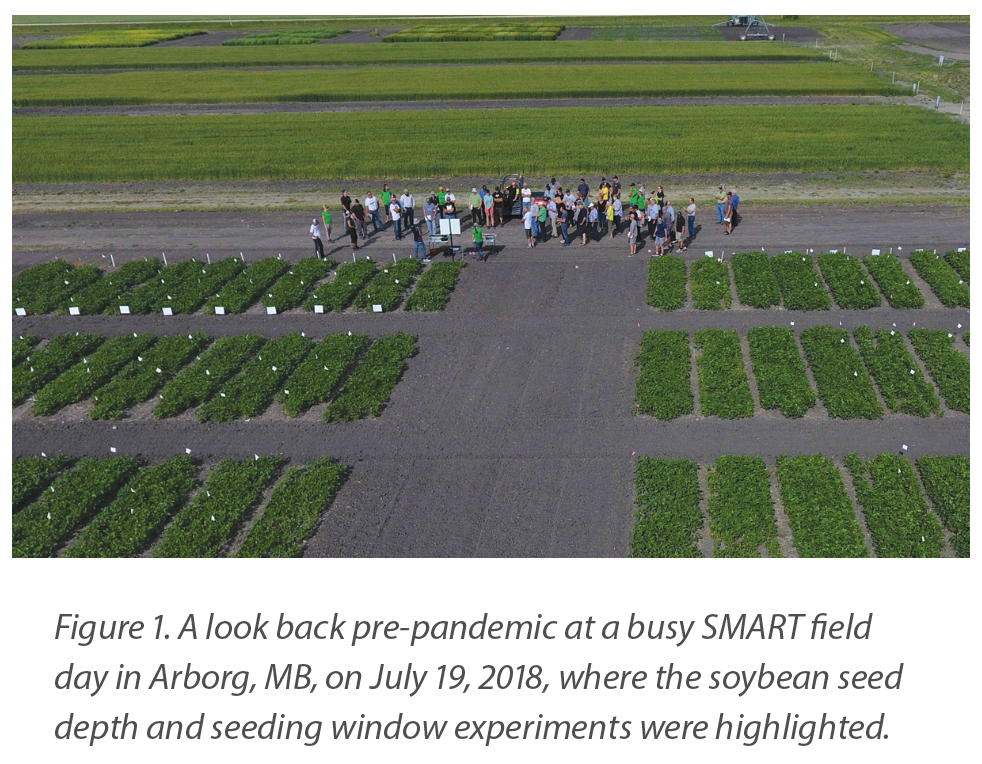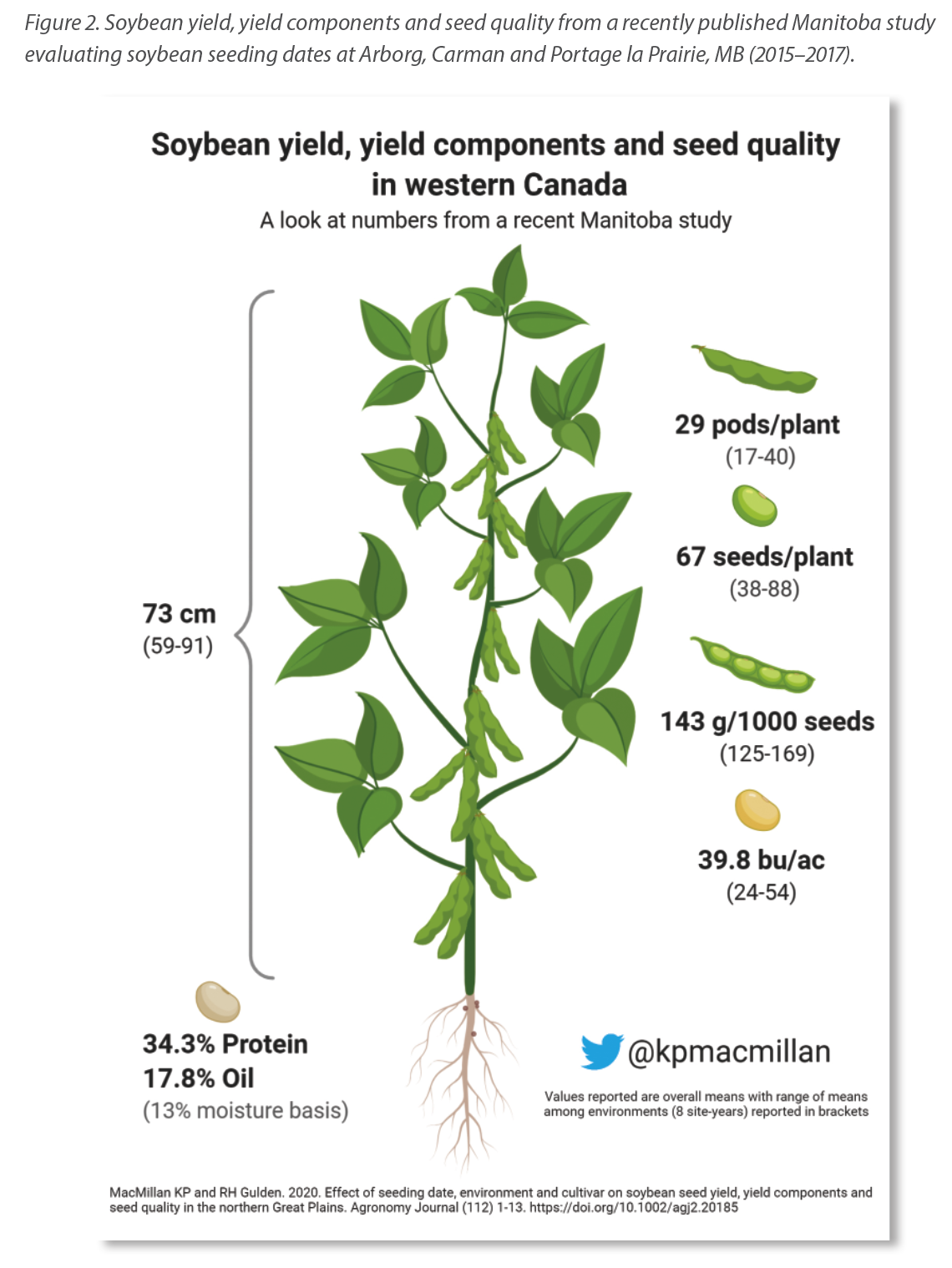An update from the soybean and pulse agronomy research program
Kristen P. MacMillan, MSc, PAg, Agronomist-in-Residence, Department of Plant Science, University of Manitoba – Fall/Winter (December) Pulse Beat 2020
 It’s been over a year since I last wrote in Pulse Beat and there is no shortage of things to catch up on. First, my husband and I proudly welcomed our first child into the world. If you can think of all the clichés of being first-time parents, we’ve recently been there. That includes timing naps around rides in the combine and seeder.
It’s been over a year since I last wrote in Pulse Beat and there is no shortage of things to catch up on. First, my husband and I proudly welcomed our first child into the world. If you can think of all the clichés of being first-time parents, we’ve recently been there. That includes timing naps around rides in the combine and seeder.
Now while all that fun stuff was happening at home, the momentum kept up at work. Pea agronomy research was initiated, a soybean paper was published and 2019 was our busiest research season with 20 field trials spread across six locations in Manitoba. The reality that I became a mother during our busiest field season speaks volumes to the team behind the soybean and pulse agronomy research program. I want to acknowledge Brodie Erb, Ishan Samaranayake, Nate Ort and Mike Erb, along with our summer students, for providing top-notch technical support. To borrow an analogy from one of my mentors, Don Flaten, they are truly self-propelled. Field research activities resumed during my maternity leave and I even made a few trips to the field and office with my daughter.
The 2020 growing season has also been busy as we all continue to navigate a global pandemic. New protocols are in place for us to continue working together while staying apart, and despite some reduction in capacity, research continues. The most significant change is the number of people who work on the University of Manitoba campus, with capacity restricted to 20–40% of people at any given time. My return to work this summer was greeted not by farmers and agronomists at field days (Figure 1), but rather by a pile of data and virtual meetings in my home office. Looking ahead to this winter, the primary source of information from the soybean and pulse agronomy program will be the annual report. Until then, my field crew will be busy processing samples and organizing data, and I’ll be at my computer – crunching numbers and writing reports. For now, here’s a reminder of our activities in soybeans, dry beans and peas.
Soybeans
Studies evaluating the optimum seeding window and seed depth for soybeans, and yield response to fungicide application, wrapped up in 2019 and final results are being analyzed. We once again harvested the soybean iron deficiency chlorosis (IDC) variety evaluation site and continue to evaluate the relationship between IDC and yield. In 2021, I will be looking to survey soybean fields that are prone to IDC. If you have a field of soybeans planned for 2021 that consistently expresses yellowing due to IDC, please contact me at kristen.macmillan@umanitoba.ca.
In other soybean work, we started collaborating with Dr. Charles Geddes in 2019 to test integrated weed management strategies for soybeans. The management practices being tested are variety choice, preceding crop type, residue management and seeding date. The objective is to determine if these cultural practices affect soybean’s ability to compete with or withstand weed competition.
Lastly, we continue to test new soybean intercrop and relay crop systems. These include a soybean-flax intercrop, winter wheat-soybean relay crop and fall rye-soybean relay crop. We are testing different seeding rate ratios for the soybean-flax intercrop, and for the relay crop systems, we are evaluating multiple row spacings.
First soybean publication
 Just before my daughter came into the world, I was working on a paper to share new insight with the scientific community on how soybeans grow in our prairie environment. During maternity leave, somehow between infrequent naps and sleepless nights, this paper was submitted, revised, accepted and published in the Agronomy Journal. This publication expands on a previous seeding date study that produced data to re-evaluate Manitoba’s soybean seeding deadlines. It is a landmark study for western Canada, characterizing soybean yield, yield components and seed quality for modern varieties that will help researchers across North America understand and improve soybeans for the Canadian prairies. A summary of the data is presented here in a neat info-graphic (Figure 2) and the open-access journal article can be found at this link: https://doi.org/10.1002/agj2.20185.
Just before my daughter came into the world, I was working on a paper to share new insight with the scientific community on how soybeans grow in our prairie environment. During maternity leave, somehow between infrequent naps and sleepless nights, this paper was submitted, revised, accepted and published in the Agronomy Journal. This publication expands on a previous seeding date study that produced data to re-evaluate Manitoba’s soybean seeding deadlines. It is a landmark study for western Canada, characterizing soybean yield, yield components and seed quality for modern varieties that will help researchers across North America understand and improve soybeans for the Canadian prairies. A summary of the data is presented here in a neat info-graphic (Figure 2) and the open-access journal article can be found at this link: https://doi.org/10.1002/agj2.20185.
One of the takeaways from this publication and an emerging theme in my research is the importance of environment in determining soybean yield. Soybeans are somewhat unique compared to other crops like wheat, canola and corn, which are highly responsive to management practices like fertility and spatial arrangement (in addition to environment). The “environment” refers to soil, landscape and weather conditions that interact each growing season and are proving to be more influential on soybean outcomes than many management practices, including variety choice, seeding date and fungicide application. That doesn’t mean you shouldn’t continue using best management practices, but I do think some of that focus should be shifted to environment (field) management. What aspects of each field on your farm promote or limit crop yields? Can they be improved? Are they being addressed?
Peas
In response to the progress being made in the plant protein industry, the 2020 growing season marks the first year that we embark on dedicated pea agronomy research. In our first experiment, we are seeking to answer the following questions for farmers and agronomists:
- Is pea yield affected by stubble type (wheat vs. canola)?
- Does residue management (tilled or direct seed) affect pea productivity?
- Do peas respond to starter phosphorus and does placement matter (seed placed vs. sideband vs. none)?
- Do these management practices interact?
As pea production opportunities expand in Manitoba, no local research is available to support these agronomic decisions, which are important for maximizing pea productivity. Currently, approximately 38% of Manitoba pea acres are grown on wheat stubble and 20% on canola stubble, with crop insurance data pointing towards a yield advantage to wheat stubble (MASC 2015–2018). Meanwhile, less than half of western Canadian farmers are applying phosphorus for pea production (Stratus Ag Research 2015). And while no data is available on residue management practices, peas are tolerant to early seeding into cool soil, which presents an opportunity for reduced or rotational tillage systems.
While this is the first experiment focusing specifically on peas, we continue to evaluate new pea intercrop and relay crop systems. These include pea-canola, pea-flax and pea-oat intercrops as well as fall rye-pea and winter wheat-pea relay crops.
Dry beans
The dry bean nitrogen fertility experiment where we evaluated the response of Windbreaker pinto beans and T9905 navy beans to five rates of N fertilizer (0, 35, 70, 105 and 140 lbs/ac) ended in 2019. I’m currently analyzing and summarizing the data for release this winter. In the first two years of the study, it was clear that beans were able to produce respectable yields without the addition of N fertilizer, but the economics were unclear. This finding and the observation of nodulation has fuelled my quest to better understand our N strategy and N fixation capacity of dry beans. During winter extension meetings in 2019, I connected with two companies that had new inoculant offerings for western Canada. We put these to the test in 2019 and 2020 at Carman and Melita. Stay tuned for these brand-new results this winter. Some farmers have also tested N management practices through MPSG’s On-Farm Network.
We are also closer to understanding the impact of preceding crop type and residue management on dry bean productivity. We just harvested the final crop of pinto beans in that experiment at Carman and Portage.
The annual report from the Soybean and Pulse Agronomy Lab will be available this winter and include results and updates from these experiments.
Stay tuned!
References
Manitoba Agricultural Services Corporation (MASC). 2010-2015. Crop rotation and yield information. MASC [Online]. Available: https://www.masc.mb.ca/masc.nsf/mmpp_crop_rotations.html
Stratus Ag Research. 2015. Canadian Fertilizer Use Survey. Stratus Ag Research [Online].
